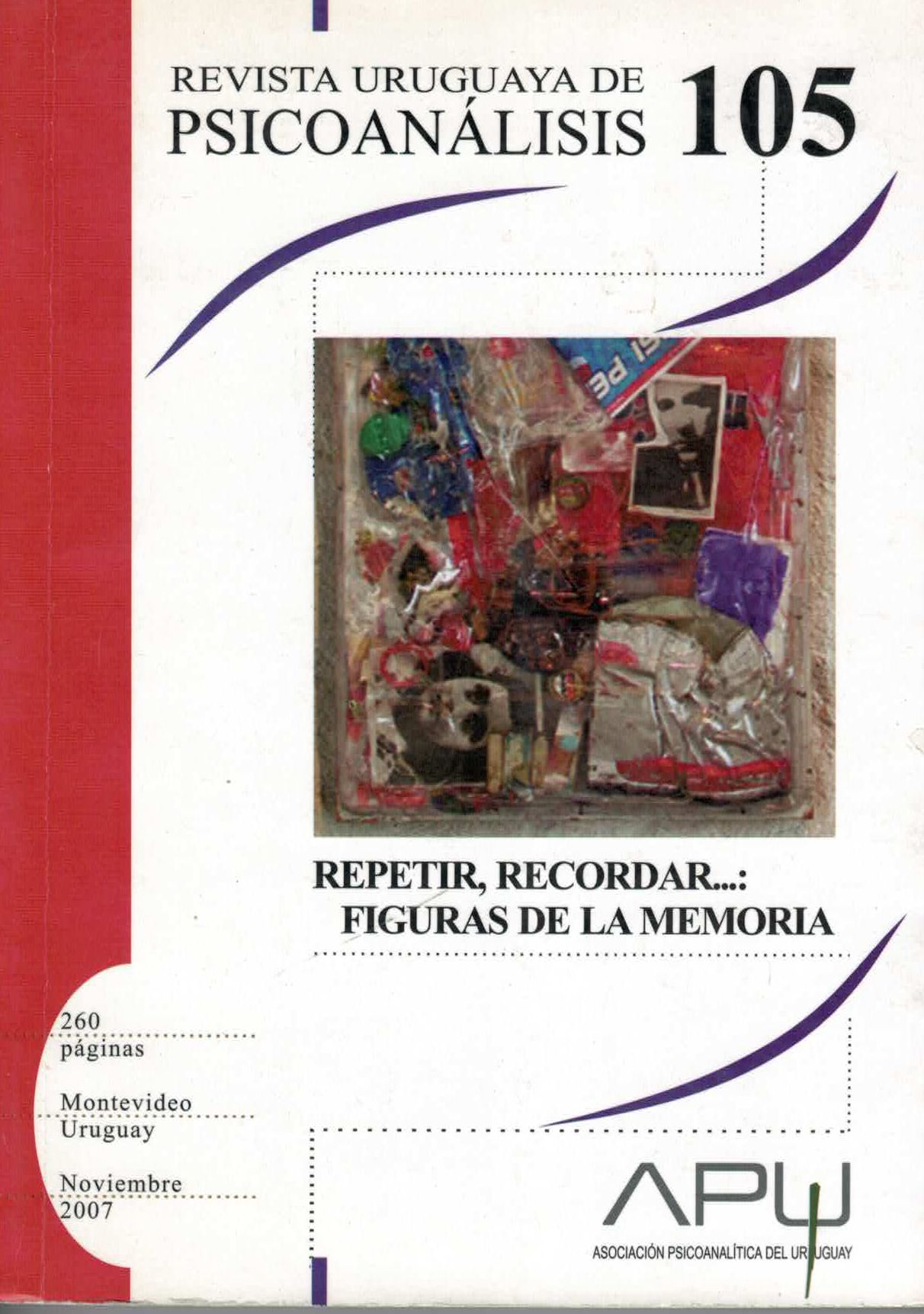Interpretation and intersubjectivity: New challenges of the analytical process. Freud’s legacy 150 years from his birth
Keywords:
intersubjetividad, enactment, memoria, material clínicoAbstract
Both, analytical practice and research, have shown as new challenges in the psychoanalytic production of the last decades,
the relevance that acquire for the process of change, the different forms in which patient and analyst establish their communication.
All the psychoanalysts consider the interpretation to be their principal instrument and something that distinguishes them in their
labor together with the patient, though many agree that it is not a decisive thing.
In the present work the intersubjectivity is born in mind in the analytical process, in the sense of one “slightly beyond” of the
words, from a vision of the analyst forming an active part of the intersubjective field, being outlined the quality of the therapeutic
relation as curative factor.
The exposed thing leads to arrange hierarchically the notion of enactment, that has been receiving every time major importance
in the psychoanalytic theory and technique. This concept comes to question strongly the idea of an analyst interpreter of a reality
who is externally of him, in the patient, but in any case he is someone who takes part, acts and then he tries to explain something
of what has happened between both. From previous thoughts exemplified with a clinical material,
a series of hypothesis approach in relation to the current perspectives linked to the different forms of relationship (verbal
and not verbal) that take place in the analytical encounter, where they occupy a fundamental place the current knowledge in the
field of the memory, particularly those forms related to the inscription of links, which we would be interested exceedingly as
psychoanalysts. The previous is considered to be an attempt of reaffirmation of Freud’s proposal, but to include it inside a wider view that contemplates the developments that have been produced to his work 150 years from his birth.
Downloads
References
AHUMADA, J. (1994): Interpretation and creationism. Int.J.Psychoanal. 75.4:695-709.
ANDRADE DE AZEVEDO, A.M.(1994): “Validación del proceso clínico psico-analítico: el papel de los sueños”. Int. J. Psycho-Anal (1994),
X, 191.
BARANGER, M.; BARANGER, W.(1961-62): “La situación analítica como campo dinámico”. Rev. Ur. De Psic. T. IV, Nº. 1 (1961-62) pp.3-
BERNARDI, R. (2005): ¿Qué después del pluralismo? Ulises aún en camino. R.U.P. 2005. N.100: 270-290.
BLEICHMAR, H. (1999): El cambio terapéutico a la luz de los conocimientos actuales sobre la memoria y los múltiples procesamientos
inconcientes. Nov. 2001 Nº. 9 www.aperturas.org (2005) Int.J. Psychoanal.
(2003): Hacer conciente lo inconciente para modificar los procesamientos inconcientes: algunos mecanismos del cambio
terapéutico.
DAVIES, T. (2001): Revising psychoanalytic interpretations of the past. An examination of declarative and non declarative memory processes. Int. J. Psychoanal.82 : 449 - 462.
DE LEÓN DE BERNARDI, B. (2005): Narrativa y psicoanálisis: alcances y límites de la palabra- RUP. Nº 100, mayo 2005, pp.170-202.
ETCHEGOYEN, H. (1990): Un ensayo sobre la interpretación psicoanalítica. Ed. Polemos, Buenos Aires
FERRO, A. (1999): El psicoanálisis como literatura y terapia. Grupo Editorial Lumen, Argentina. 2002.
FREUD, S. (1914): Recordar, repetir y reelaborar. (Nuevos consejos sobre la técnica del psicoanálisis II) T. XII Amorrortu Ed. Bs. As. 1990.
FONAGY, P. (1999) Guest Editorial: Memory and therapeutic action. Int. Journal Psychoanal.8:215-225.
JIMÉNEZ, J.P. (in press) After pluralism: Towards a new, integrated psychoanalitic paradigm. Int. Jour. Psycho Anal.
KLEIN, M. (1957) Envidia y Gratitud y otros trabajos. O.C. Vol. 3 Bs. As. Paidós. 1987 pp.181-240.
LEIVOVICH DE DUARTE, A.S. (1999) Restos y rastros del pasado. Historia y narrativa en psicoanálisis. Rev. De la Soc. Argentina de
Psicoanálisis Nº 2 Julio 1999 pp. 91-102.
MATTE BLANCO, J. (1988): Thinking, feeling and being. Clinical reflections on the fundamental antinomy of human being and world.
London, Routhledge (pp. 162-164).
MORENO, E. (2000) A propósito del concepto de “enactment”. Aperturas psicoanalíticas. Revista de Psicoanálisis. Abril, 2000. Nº. 4
www.aperturas.org
NIETO, M. (1970): De la técnica analítica y las palabras.Comentado por W. Baranger, D. Liberman y Ezra Heymann. R.U.P. TXXII Nº.3
pp. 169-2.
TUTTÉ, J.C. (2002): Memoria y psicoanálisis: Actualidad de un viejo problema. R.U.P. 96, pp.171-174
(2004): The concept of psychical trauma: A bridge in interdisciplinary space. Int. J. Psyco-Anal. 85. pp. 897-921.
(2006) El concepto de trauma psíquico: un puente en la interdisciplina. Aperturas Psicoanalíticas Nº. 23. www.aperturas.org
(2006) Proceso psicoanalítico : interpretación e intersubjetividad. El legado de Freud a 150 años de su nacimiento. Aperturas
psicoanalíticas. Revista de Psicoanálisis. Diciembre 2006. Nº 24.
www.aperturas.org
STERN, D., SANDLER, L., NAHUM, J., HARRISON, A., LYONRUTH, K., MORGAN, A., BRUSCHWEILER-STERN, N. and
TRONICK, E. (The process of change study group). (1998): Noninterpretive mechanism in psychoanalytic therapy. The “something more”
than interpretation. Int.J. Psycho. Anal 79. pp. 903-921.
WALLERSTEIN, R. (1988): One psychoanalysis or many? Int. J. Psyco-Anal.69: 5-21.
ZAC, J. (1972): Cómo se originan las interpretaciones en el analista.Comentado por: José Bleger, Luis A. Chiozza, David Liberman y
Emanuel Windholz. Revista de Psicoanálisis. Ed. APA T XXIX Nº.2 Abril-Junio 1972 Buenos Aires. pp.217-252.
ZAC, J. (1974): La búsqueda de la articulación del psicoanálisis y la epistemología. Revista de Psicoanálisis. Ed. APA TXXXI Nº. 1-2 EneroJunio 1974, Buenos Aires, pp. 459-501.



 This work is licensed under a
This work is licensed under a 